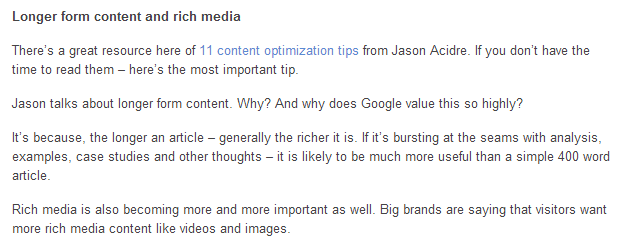Some online marketers and SEO experts believe that guest blogging is dead.
But is it really?
We see people publishing blog posts on other websites all the time. During that process, they also build backlinks to their own blogs or websites. After all, they have to redirect traffic to their own website, right?
You see, guest blogging was extensively used for link-building purposes in the past. Now the trend has waned a little bit, but that does indicate that guest blogging cannot be effective anymore.
It all started when Matt Cutts one day suggested that guest blogging is dead. There was a massive uproar on the internet, but the dust settled quickly.
Matt Cutts also explained what he meant.
In short, he wanted to highlight the fact that if you are trying to game Google with building backlinks via guest blogging, it is not going to work. Guest blogging should be primarily used for increasing your exposure, reaching out to new readers and potential customers, and just sharing valuable content and information across the web. The backlinks that are generated via guest blogging are kind of like byproducts.
This is a slight adjustment to the mindset — which can be crucial.
Having said that, backlinks still represent an important aspect of guest blogging. Nobody goes through the trenches, writes a high-quality blog post, manages to get it published on a high-profile website, and not generate a link back to her own website.
So, whether you are guest-blogging for expanding your reach or specifically for building backlinks, there are certain things that you need to remember. Otherwise, Google might penalize you.
In this blog post, we share 6 important tips that you must remember when using the guest-blogging technique to generate backlinks to your website.
1. Carefully Pick Target Websites

When you start guest-blogging, you will soon realize that there are three categories of websites you can get in touch with:
- Elite websites — like The Huffington Post, Forbes, Mashable, Wired, etc. — are extremely high-profile. These are powerful websites that are very difficult to get your guest posts on.
- On the other hand, there would be smaller, less powerful websites. These websites are good but obviously not as powerful as the ones mentioned in the first category.
- Then comes the third. The bottom of the barrel. These websites are willing to accept whatever you throw at them because they need content and don’t really care about their readers. They don’t care about user experience, and they over-optimize content with affiliate links and ads.
Ideally, you would like to get on the first-category websites. However, the second category isn’t bad either. In fact, you can leverage your guest-posts from the second category websites to get on the elite websites. So that’s recommended, too.
However, you must avoid the third-category websites. Links from these websites are going to do more harm than good.
Google actively penalizes such websites, and links from them won’t do you any favor when it comes to that.
2. Mind Your Niche
Before you start guest blogging and pick websites to target, it is important to remind yourself the business niche you are in.
If you have a website on gardening, it makes no sense to build backlinks from a casino-related website just because it’s easier to get a guest post on.
First, it does not add any value for the online readers. Second, Google hates such links that come from unrelated websites. Google Penguin, in fact, actively penalizes websites that have too many unrelated backlinks. On the other hand, websites with 100% relevant backlinks aren't generally penalized in the same way.
Therefore, backlinks from unrelated websites — websites that do not belong to your niche or target audience — get you penalized by search engines. And you must avoid such backlinks, no matter how easy it is to get them.
3. Anchor Text Diversification
Don’t use the same keywords over and over again as anchor texts when building links with guest posts.
It is unnatural, and Google can see that.
You need to understand that Google wants a natural backlink profile — one without any interference from you or anyone else.
Google wants people to create links to your website because they think you have the most amazing content that their readers would enjoy and find useful — not because you wanted them to create those links.
And if people across the web are naturally creating those links, do you think they would all use the same keywords when they are linking to your website?
No.
In fact, almost everyone might use different — or, at least, slightly different — keywords for the anchor text.
When you are in control of your backlinks, make sure to diversify the anchor texts. Otherwise, it would appear unnatural to Google and might lead to a penalty in the search engine results pages.
4. Create Deep Links
As we just mentioned, Google wants to see a natural backlink profile.
It means that you can’t just redirect all the backlinks to your website’s homepage. When you are guest-publishing lots of blog posts, make sure to direct some to other web pages, deep inside your site’s structure.
For example, some backlinks could be created for your homepage; some to other blog posts, and some to landing pages on your website.
The SEO juice (backlink power) is distributed across the website, so it does not matter much. But creating deep links makes your backlink profile appear more natural. Moreover, this technique of creating deep backlinks also helps you optimize web pages on your website other than just the homepage.
5. Don’t Forget Contextual Links
When publishing guest-posts, make sure to create contextual links. Never miss that opportunity.
If you don’t know, there are two types of backlinks that are often seen in the guest blogging process. We can categorize them into the following two categories:
- Author-bio links: These links are at the end of the guest-post, i.e., in the author-bio link, where the author mentions his own website and redirects users to them.
- Contextual links: Contextual links appear naturally within the text of the blog post. They are not highlighted separately like the author-bio links.
Following is an example of contextual backlinks, “11 content optimization tips”.
It is believed that contextual backlinks are up to 5x more powerful than author-bio links. As they appear more natural and useful to readers, Google values these links a lot more.
Also, contextual links allow you the opportunity to link to several of your own blog posts — assuming they add value and make sense in a specific blog post.
6. Do Not Overdo Guest Blogging
Guest blogging is a great way to generate leads, increase business exposure
However, if you are only trying to use guest blogging as a tool for building backlinks, you should refrain from overdoing it.
It is easy to get lost in this.
Once you get the ball rolling, you might find yourself getting opportunities for multiple blog posts at once. Also, when you reach out to other blogs, you reach out to dozens of blogs simultaneously.
Then you leverage the guest posts that you have already published and reach out to some other websites.
It just goes on and on and on. You just keep digging into it.
However, if all your backlinks are coming from guest blogging, it might tick off Google.
Google wants to see a natural backlink profile, and it can’t just consist of backlinks from guest posts.
So, when you are formulating a guest-blogging strategy, make sure to keep this important point in mind.
Final Words
Guest blogging is still an effective method to reach out to new potential customers as well as build powerful backlinks. But you need to be smart about it.
You need a proper strategy in place.
Remember the lessons and tips shared in this blog post. If you do it right, you can utilize the power of guest blogging and build powerful backlinks to help propel your website in the SERPs.
